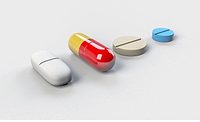Workforce Drug Positivity Rises by Double-Digits in Almost One-Third of U.S. Industry Sectors Examined

Drug use by the U.S. workforce increased each year -- and by double-digits over two years -- between 2015 and 2017, in five of 16 major U.S. industry sectors analyzed, according to a first-ever analysis of industry-specific data from more than ten million urine drug test results performed by Quest Diagnostics.
The data from the Quest Diagnostics Drug Testing Index™ industry analysis show that the Retail Trade (5.3%), Health Care and Social Assistance (4.7%), and Real Estate Rental and Leasing (4.6%) sectors had the highest overall positivity rates in 2017, while the Utilities (2.8%) and Finance and Insurance (2.6%) sectors had the lowest rates.
Five sectors experienced year-over-year increases with a double-digit increase in their positivity rates between 2015 and 2017: Transportation and Warehousing (21.4%); Other Services (Except Public Administration) (15.4%); Finance and Insurance (13%); Retail Trade (12.8%); and Wholesale Trade (11.8%).
"Our analysis suggests that employers can't assume that workforce drug use isn't an issue in their industry. In fact, drug test positivity in the majority of industry sectors analyzed is growing," said Barry Sample, PhD, senior director, science and technology, Quest Diagnostics Employer Solutions. "The highest rates were in consumer-facing industries, including jobs in Retail and Health Care and Social Assistance."
In a 2017 survey by the National Safety Council, 71 percent of employers reported being directly impacted by prescription drug misuse in their workforce, including absenteeism, decreased productivity, and on-the-job near miss or injury.
Classifications were based on the North American Industry Classification System (NAICS), used by the U.S. Office of Management and Budget, Canada, and Mexico to group organizations into industries based on the similarity of their production processes. Sixteen of the 20 industry sectors were included in the Quest analysis; four classifications were excluded due to insufficient testing volume.
Marijuana tops the list as the most detected substance
Consistent with the annual Drug Testing Index report, marijuana was the most commonly detected substance, with the highest drug positivity rate of all drug classes across the majority of industry sectors. Marijuana positivity was highest in Accommodation and Food Services, at 3.5 percent in 2017, more than 34 percent higher than the national positivity rate of 2.6 percent for the general U.S. workforce.
Eight sectors experienced year-over-year increases with at least 20 percent increases in marijuana positivity rates between 2015 and 2017:
- Transportation and Warehousing (33.3%)
- Other Services (except Public Administration) (33.3%)
- Construction (26.7%)
- Wholesale Trade (23.5%)
- Manufacturing (23.1%)
- Accommodation and Food Services (20.7%)
- Administrative Support, Waste Management and Remediation Services (19.0%)
- Retail Trade (18.5%)
Other observations by drug category include:
- The amphetamine positivity rate grew year-over-year and nearly 14 percent between 2015 and 2017 in the Educational Services sector, and rose by nearly 16 percent in the Health Care and Social Assistance sector. Amphetamine is a central nervous system stimulant and includes drugs such as Adderall® that may be prescribed for certain conditions, but which may also be used illicitly.
- Methamphetamine positivity was highest in the Construction sector in each of the three years analyzed, and experienced a 15 percent increase during that period. Methamphetamine, which is a prescription drug but is most often associated with illicit use and production in clandestine laboratories, is a potent version of amphetamine that has more harmful effects on the central nervous system and has a high potential for misuse.
- Cocaine positivity is higher in most sectors in 2017 as compared to 2015. The following sectors experienced the greatest year-over-year increases in cocaine positivity between 2015 and 2017:
- Retail Trade (42.9%)
- Administrative Support, Waste Management and Remediation Services (35.3%)
- Transportation and Warehousing (22.7%)
Positivity varies significantly in prevalence and by drug among industry sectors
Among other industry-specific findings:
- The Retail Trade sector, with the highest 2017 positivity rate among the sixteen sectors reported, observed increases in overall positivity in each year between 2015 and 2017 (positivity rate of 4.7% in 2015, 5.1% in 2016, 5.3% in 2017). In addition to a nearly 43 percent growth in cocaine positivity between 2015 and 2017 -- overall twice the increase of the general U.S. workforce -- marijuana positivity increased more than 18 percent in the sector.
- Between 2015 and 2017, the Transportation and Warehousing sector experienced the largest overall positivity increase of any sector, in large part due to significant increases in both cocaine and marijuana positivity. Year-over-year cocaine positivity increased more than 22 percent between 2015 and 2017 (0.22% in 2015, 0.25% in 2016, and 0.27% in 2017). Marijuana positivity increased by more than 33 percent over the same timeframe.
- Educational Services topped the list for amphetamine positivity in all three years of the analysis (1.45% in 2015, 1.6% in 2016, and 1.65% in 2017), equating to an increase of nearly 14 percent. At the same time, the sector saw the largest year-over-year decline in methamphetamine positivity of any sector analyzed, declining nearly 29% between 2015 and 2017.
- The Construction sector ranked highest among industries for cocaine positivity (0.41% in 2017) – more than 33% higher the general U.S. workforce. The Construction sector also exhibited a more than 26 percent increase in marijuana positivity between 2015 and 2017.
- In the Manufacturing sector, both marijuana and methamphetamine positivity increased year-over-year, by more than 23 and 27 percent, respectively, between 2015 and 2017.
- The Wholesale Trade sector experienced double-digit growth in overall positivity from 2015 to 2017, largely related to the more than 36 percent and 24 percent increases in methamphetamine and marijuana positivity, respectively, during that time period.
- The Information sector showed the largest growth (more than 20%) in amphetamine positivity between 2015 and 2017, but was the only sector to experience a year-over-year decline (more than 8%) in marijuana positivity during that same three-year period.
- Other Services (except Public Administration) showed large increases in positivity for marijuana (more than 33%) and cocaine (19%) between 2015 and 2017.
Looking for a reprint of this article?
From high-res PDFs to custom plaques, order your copy today!





